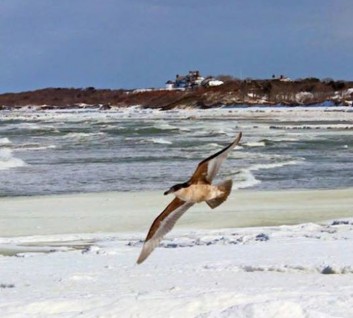Wayne R. Petersen

by Stephanie Ellis
This month’s puzzler offers a combination of challenges, due mainly to extreme lighting conditions, more obvious in the online colored version of the photo than in this black and white mystery bird. To identify this seemingly ambiguous bird, try to imagine the image as being simply solid gray or black. Try to ignore the dark wing- linings, dark cap, and whitish or pale undertail coverts.
Seeing only the bird’s profile, we are left with a fairly hefty, long-winged bird with pointed primaries, apparently buffy or off-white underparts, and a relatively short and dark rounded tail. The bill appears to be stout, blunt, dark-tipped, and deep (from top to bottom). That the bird is obviously flying over a coastal beach is another useful clue. Perhaps even more important, the beach is snow-covered. While seemingly irrelevant at first, the snow in the picture goes a long way to explaining the ambiguous appearance of the mystery bird; the extreme lighting conditions caused by the snow are largely responsible for the unusual appearance of this mystery species.
Returning to the suggestion of picturing the bird as uniform gray or black (i.e., like a silhouette), it should not be too hard to imagine the bird as a gull, especially since it is flying over a winter beach. Strong reflected light off the brightly illuminated snow accentuates the contrast between the bird’s dark wing linings and the rest of the underwings. The tail appears similarly dark due to the reflected light from the snow. The appearance of a dark cap, a feature that gives the bird the superficial appearance of a Great Shearwater, is due to the shadowing effect produced by strong light coming off the snow on the ventral surface of the bird. A close look at the colored version online also reveals the pink color of the bird’s legs and the bicolored bill, which are characteristic of a first-cycle Herring Gull. Indeed, the mystery photograph is nothing more than a unique photograph of a young Herring Gull (Larus argentatus) taken under extreme lighting conditions. The ultimate value of this photograph is the way it shows how unusual lighting conditions can influence our perception of even the most common species.
Herring Gulls, abundant year-round residents in Massachusetts, breed at a number of coastal and offshore island locations. They are also locally common inland wherever refuse or extensive open water occurs. Stephanie Ellis captured this unusual image of a young Herring Gull in Orleans in February 2015.